The Disposable Plastic Pallet Market is estimated to be valued at USD 8.7 billion in 2025 and is projected to reach USD 19.2 billion by 2035, registering a compound annual growth rate (CAGR) of 8.3% over the forecast period.
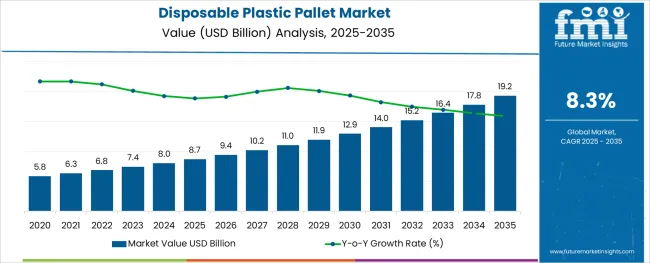
The disposable plastic pallet market is being driven by the rise of efficient supply chain management and sustainability-focused logistics. As industries strive for cost-effective, hygienic, and lightweight alternatives to traditional wooden pallets, disposable plastic pallets have seen increased adoption across sectors such as food and beverage, pharmaceuticals, and retail.
Improved polymer formulations and recyclable resin blends are enabling better durability while maintaining affordability. Furthermore, the integration of injection molding techniques and automated manufacturing systems have reduced per-unit costs and enabled high-volume output.
Regulatory pressure to eliminate contaminants and meet rigorous safety standards particularly within the food and beverage industry is also enhancing demand for single-use, sanitized pallet solutions. The forecast indicates steady CAGR expansion, supported by growth in e-commerce, global cold-chain logistics, and a push toward plastic circularity via recycling initiatives within packaging and handling ecosystems..
The market is segmented by End Use Industry, Product Type, Technology Type, and Material Type and region. By End Use Industry, the market is divided into Food and Beverage, Healthcare, Consumer goods, Logistics, Chemical, and Others. In terms of Product Type, the market is classified into Single faced and Double faced. Based on Technology Type, the market is segmented into Injection Moulding, Thermoforming, and Blow Moulding. By Material Type, the market is divided into High density polyethylene (HDPE), Polypropylene (PP), and Polyethylene terephthalate (PET). Regionally, the market is classified into North America, Latin America, Western Europe, Eastern Europe, Balkan & Baltic Countries, Russia & Belarus, Central Asia, East Asia, South Asia & Pacific, and the Middle East & Africa.

It is noted that the food and beverage sector accounts for 44.20% of market revenue, making it the leading end‑use segment. This is due to stringent hygiene regulations and traceability requirements that favor single use plastic pallets.
Elimination of cross contamination risks and adherence to clean‑room standards have been recognized as critical factors. The convenience of disposal or recycling at destination points has further enhanced operational efficiency in cold‑chain and bulk liquid handling.
As a result, food processors, beverage manufacturers, and distributors have increasingly adopted disposable pallets to streamline handling protocols, secure regulatory compliance, and minimize handling costs solidifying their leadership in market demand.
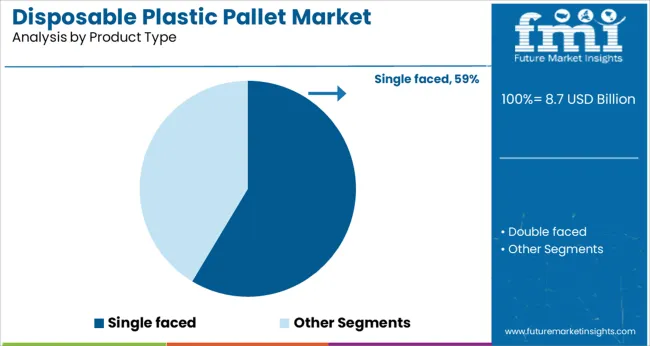
It has been observed that single faced pallets represent 58.60% of total market revenue, placing them as the dominant product type. This prominence is attributed to their lightweight design and reduced material usage, which translates into lower production costs and simplified handling processes.
Single faced pallets have been favored for one way transportation, ecommerce fulfillment, and export packaging, where return logistics are impractical. Additionally, compatibility with standard forklifts and conveyors has expedited warehouse workflows.
The reduction in carbon emissions and transportation expenses through decreased tare weight has further supported their adoption. Consequently, single faced pallets have emerged as the preferred format within the disposable plastic pallet segment.
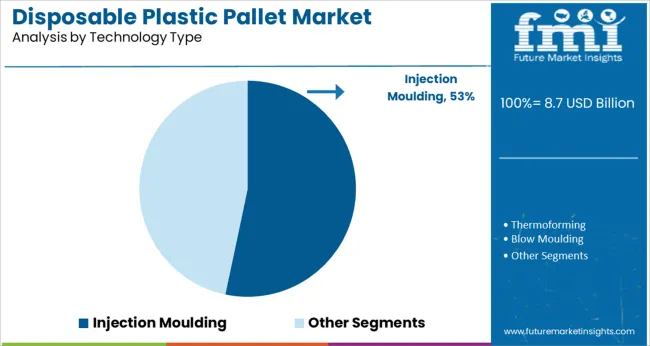
It is noted that injection moulding accounts for 53.30% of market revenue, making it the leading manufacturing technology. This dominance is due to its ability to deliver high precision, repeatable pallet designs at scale.
The process supports integrated features such as reinforced ribbing, drainage slots, and nestability, which improve structural integrity and logistical efficiency. Shorter production cycles and minimal material waste have been recognized as key enablers.
Additionally, automation and tooling advancements have lowered per-unit costs and enhanced design flexibility. These benefits have encouraged manufacturers to rely on injection moulding for disposable pallets, reinforcing its position as the core production method driving market expansion.
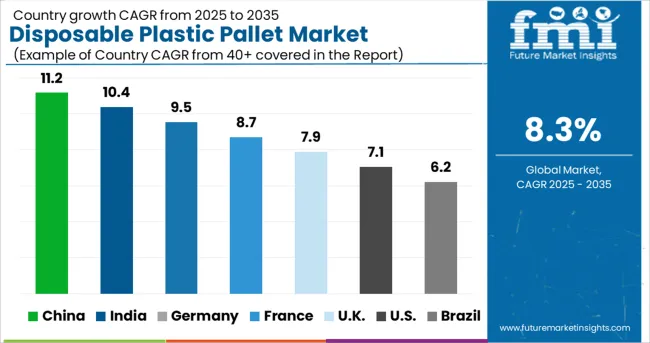
The report is a compilation of first-hand information, qualitative and quantitative assessment by industry analysts, inputs from industry experts and industry participants across the value chain.
The report provides in-depth analysis of parent market trends, macro-economic indicators and governing factors along with market attractiveness as per segments. The report also maps the qualitative impact of various market factors on market segments and geographies.
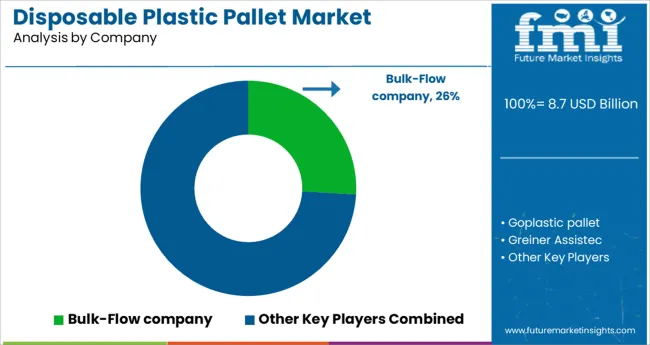
The key players of disposable plastic pallet market offers customized pallet that meet the specific requirements of customers. To sustain the extreme competition in the market, vendors are offering pooling services on a large scale to their customers, and are adopting new technologies, such as equipment tracking, and refining their service offerings. The increased implementation of modern logistics and the rapid growth of the retail industry will attract new vendors during the forecast period.
The global disposable plastic pallet market is highly competitive due to increasing preference of consumers to buy disposable plastic pallet. Some of the key players in the global disposable plastic pallet market are Bulk-Flow company, Goplastic pallet, Greiner Assistec, Agrico Plastics Ltd., SDI Packaging, Cabka North America, Inc., CTC Plastics, Enlightening Pallet Industry Co., Ltd., Schoeller Alliber, Rehrig Pacific, Brambles Limited, Plastic Products, Inc., Purus Plastics GmbH and others.
The research report presents a comprehensive assessment of the market and contains thoughtful insights, facts, historical data, and statistically supported and industry-validated market data. It also contains projections using a suitable set of assumptions and methodologies. The research report provides analysis and information according to market segments such as geographies, application, and industry.
Bulk-Flow company has designed disposable plastic pallet to carry other loads with the addition of a clip-on accessory that renders its surface flat for other type of cargo, such as smaller sacks or regular finished products
The global disposable plastic pallet market is estimated to be valued at USD 8.7 billion in 2025.
It is projected to reach USD 19.2 billion by 2035.
The market is expected to grow at a 8.3% CAGR between 2025 and 2035.
The key product types are food and beverage, healthcare, consumer goods, logistics, chemical and others.
single faced segment is expected to dominate with a 58.6% industry share in 2025.






Our Research Products

The "Full Research Suite" delivers actionable market intel, deep dives on markets or technologies, so clients act faster, cut risk, and unlock growth.

The Leaderboard benchmarks and ranks top vendors, classifying them as Established Leaders, Leading Challengers, or Disruptors & Challengers.

Locates where complements amplify value and substitutes erode it, forecasting net impact by horizon

We deliver granular, decision-grade intel: market sizing, 5-year forecasts, pricing, adoption, usage, revenue, and operational KPIs—plus competitor tracking, regulation, and value chains—across 60 countries broadly.

Spot the shifts before they hit your P&L. We track inflection points, adoption curves, pricing moves, and ecosystem plays to show where demand is heading, why it is changing, and what to do next across high-growth markets and disruptive tech

Real-time reads of user behavior. We track shifting priorities, perceptions of today’s and next-gen services, and provider experience, then pace how fast tech moves from trial to adoption, blending buyer, consumer, and channel inputs with social signals (#WhySwitch, #UX).

Partner with our analyst team to build a custom report designed around your business priorities. From analysing market trends to assessing competitors or crafting bespoke datasets, we tailor insights to your needs.
Supplier Intelligence
Discovery & Profiling
Capacity & Footprint
Performance & Risk
Compliance & Governance
Commercial Readiness
Who Supplies Whom
Scorecards & Shortlists
Playbooks & Docs
Category Intelligence
Definition & Scope
Demand & Use Cases
Cost Drivers
Market Structure
Supply Chain Map
Trade & Policy
Operating Norms
Deliverables
Buyer Intelligence
Account Basics
Spend & Scope
Procurement Model
Vendor Requirements
Terms & Policies
Entry Strategy
Pain Points & Triggers
Outputs
Pricing Analysis
Benchmarks
Trends
Should-Cost
Indexation
Landed Cost
Commercial Terms
Deliverables
Brand Analysis
Positioning & Value Prop
Share & Presence
Customer Evidence
Go-to-Market
Digital & Reputation
Compliance & Trust
KPIs & Gaps
Outputs
Full Research Suite comprises of:
Market outlook & trends analysis
Interviews & case studies
Strategic recommendations
Vendor profiles & capabilities analysis
5-year forecasts
8 regions and 60+ country-level data splits
Market segment data splits
12 months of continuous data updates
DELIVERED AS:
PDF EXCEL ONLINE
Key Companies & Market Share in Disposable Plastic Pallet Production
Disposable Medical Gowns Market Size and Share Forecast Outlook 2025 to 2035
Disposable Drills Market Size and Share Forecast Outlook 2025 to 2035
Disposable Food Containers Market Size and Share Forecast Outlook 2025 to 2035
Disposable Protective Apparel Market Size and Share Forecast Outlook 2025 to 2035
Disposable Plates Market Size and Share Forecast Outlook 2025 to 2035
Disposable Hygiene Adhesives Market Size and Share Forecast Outlook 2025 to 2035
Disposable Umbilical Cord Protection Bag Market Size and Share Forecast Outlook 2025 to 2035
Disposable E-Cigarettes Market Size and Share Forecast Outlook 2025 to 2035
Disposable Pen Injectors Market Size and Share Forecast Outlook 2025 to 2035
Disposable Trocars Market Analysis - Size, Share, and Forecast Outlook 2025 to 2035
Disposable Cups Market Size and Share Forecast Outlook 2025 to 2035
Disposable Electric Toothbrushes Market Size and Share Forecast Outlook 2025 to 2035
Disposable Barrier Sleeves Market Size and Share Forecast Outlook 2025 to 2035
Disposable Curd Cups Market Size and Share Forecast Outlook 2025 to 2035
Disposable Egg Trays Market Size and Share Forecast Outlook 2025 to 2035
Disposable Blood Pressure Cuffs Market Analysis - Size, Share & Forecast 2025 to 2035
Disposable Cutlery Market Size, Growth, and Forecast 2025 to 2035
Disposable Spinal Instruments Market Analysis - Size, Share, and Forecast 2025 to 2035
Disposable Lids Market Analysis - Growth & Forecast 2025 to 2035

Thank you!
You will receive an email from our Business Development Manager. Please be sure to check your SPAM/JUNK folder too.
Chat With
MaRIA